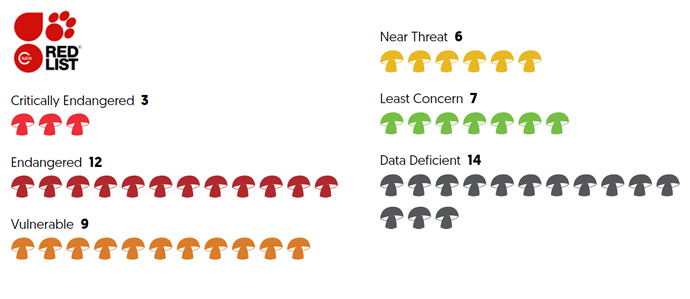International recognition for New Zealand’s endangered fungi
Established in 1964, the International Union for Conservation of Nature’s Red List of Threatened Species (www.iucnredlist.org) is a critical indicator of the health of the world’s biodiversity and the world’s most comprehensive information source on the global conservation status of animal, fungus and plant species.
 However, until recently very few fungi had been assessed for their likely Red List status. As the second largest kingdom of multicellular life, fungi were represented in the November 2009 edition of the List by only three species worldwide, along with 17,288 species of animals and plants.
However, until recently very few fungi had been assessed for their likely Red List status. As the second largest kingdom of multicellular life, fungi were represented in the November 2009 edition of the List by only three species worldwide, along with 17,288 species of animals and plants.
Dr Peter Buchanan and Dr Jerry Cooper at Manaaki Whenua have been working hard to address this problem for New Zealand’s fungi, drawing on the expertise of staff at Manaaki Whenua’s nationally significant New Zealand Fungarium in Auckland.
Following an IUCN Red List workshop in July 2019 in Melbourne, 51 assessments of Australasian fungal species were finalised to IUCN Red List standards by the end of 2019, 30 of these from New Zealand. Of the 51, 3 species were formally Red Listed by IUCN as Critically Endangered, 12 as Endangered, 9 as Vulnerable, and 6 as Near Threatened, 7 were designated as Least Concern, and 14 as Data Deficient.

Progress has also been made on assessments for another 33 species – vastly increasing the knowledge and understanding of our rarest fungi. IUCN data on New Zealand’s fungi has also been incorporated by Dr Cooper in a revision submitted to the Department of Conservation of the conservation status of over 900 species of New Zealand mushrooms.
Inclusion on the Red List doesn’t confer legal protection, but the data included in each listing provide information about range, population size, habitat and ecology, use and trade, threats, and conservation actions to help inform necessary conservation and policy decisions.
Gallery

Deconica baylisiana (the alpine pouch).

Abstoma purpureum under magnification.

Tea tree fingers (Hypocreopsis amplectens) – a critically endangered fungus.
Tea tree fingers (Hypocreopsis amplectens) is one of the three Critically Endangered species, only known from seven sites, two of which are in New Zealand. Conservation action to protect this fungus is occurring in Australia but is not yet in place in New Zealand where attempts to relocate it have so far been unsuccessful.
‘This is an especially rare and intriguing fungus, with a mysterious ecology,’ says Dr Buchanan. ’While appearing to produce its fruitbody on fallen wood, some specimens indicate that it is growing on another fungus that is itself growing on the wood. With such a distinctive finger-like appearance, we hope that keen observers might locate it and report its presence on iNaturalist.’
Other ultra-rare New Zealand fungi assessed at the Melbourne workshop include Deconica baylisiana (the alpine pouch), an orange truffle-like fungus found only in alpine grasslands and rediscovered by an iNaturalist observer in 2014 after not being seen for 50 years, and Abstoma purpureum, a sand-dune puffball that may already be extinct because of decline in habitat.
As well as expertise in this traditional type of species identification, Dr Cooper brings a wealth of experience in informatics and data management to the assessment of New Zealand’s fungal biodiversity and threatened status. ‘Modern gene sequence-based techniques are allowing us to make more sense of the hidden world of fungi,’ he says. ‘Those data, combined with the recent explosion of citizen scientists recording species on the iNaturalist platform, mean we are beginning to understand a lot more about our fungi and highlight those under threat.’
Funding from Manaaki Whenua, IUCN (UK), and from the Mohamed bin Zayed Species Conservation Fund made the Red List Assessment Workshop in Melbourne possible.
